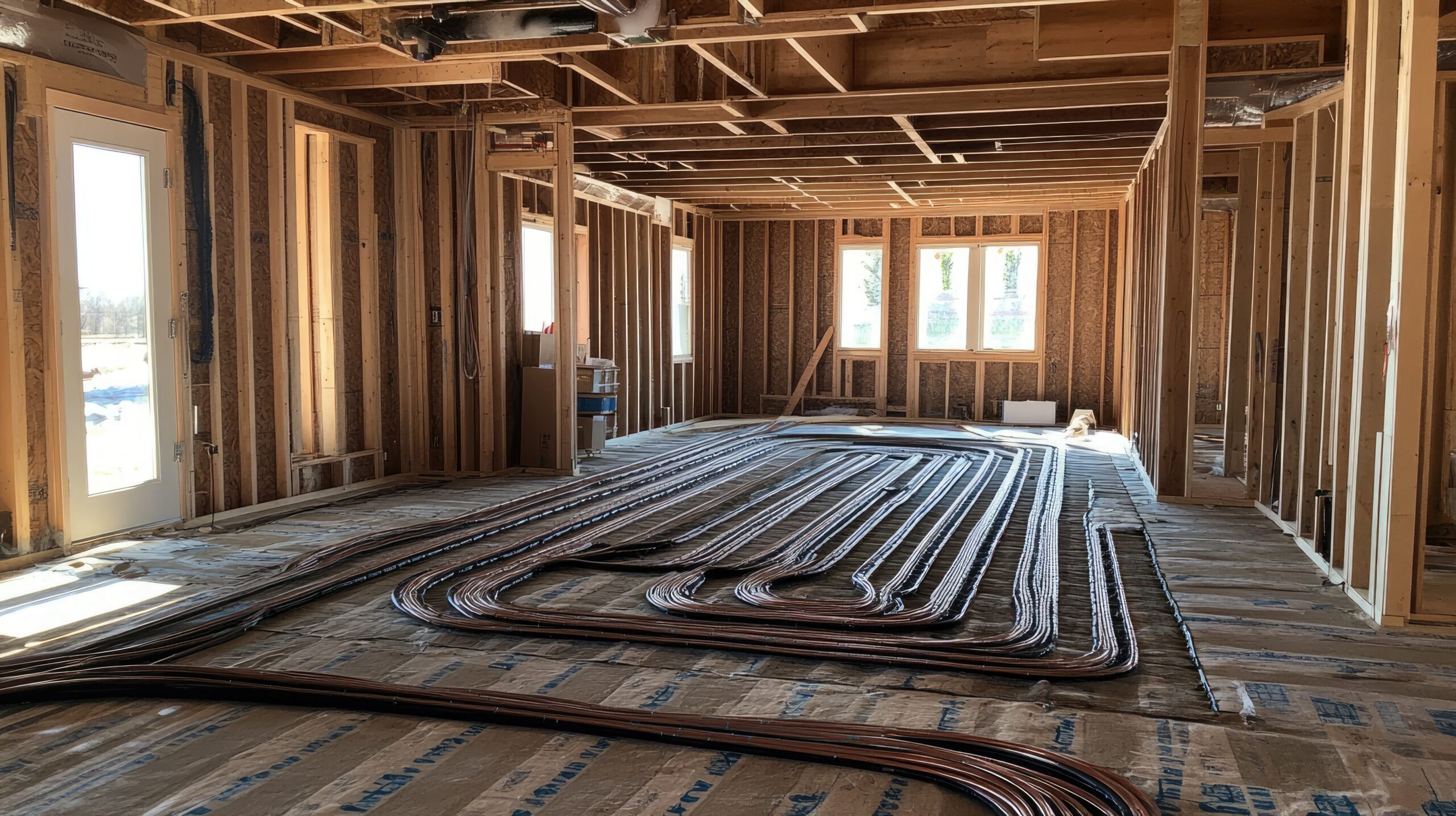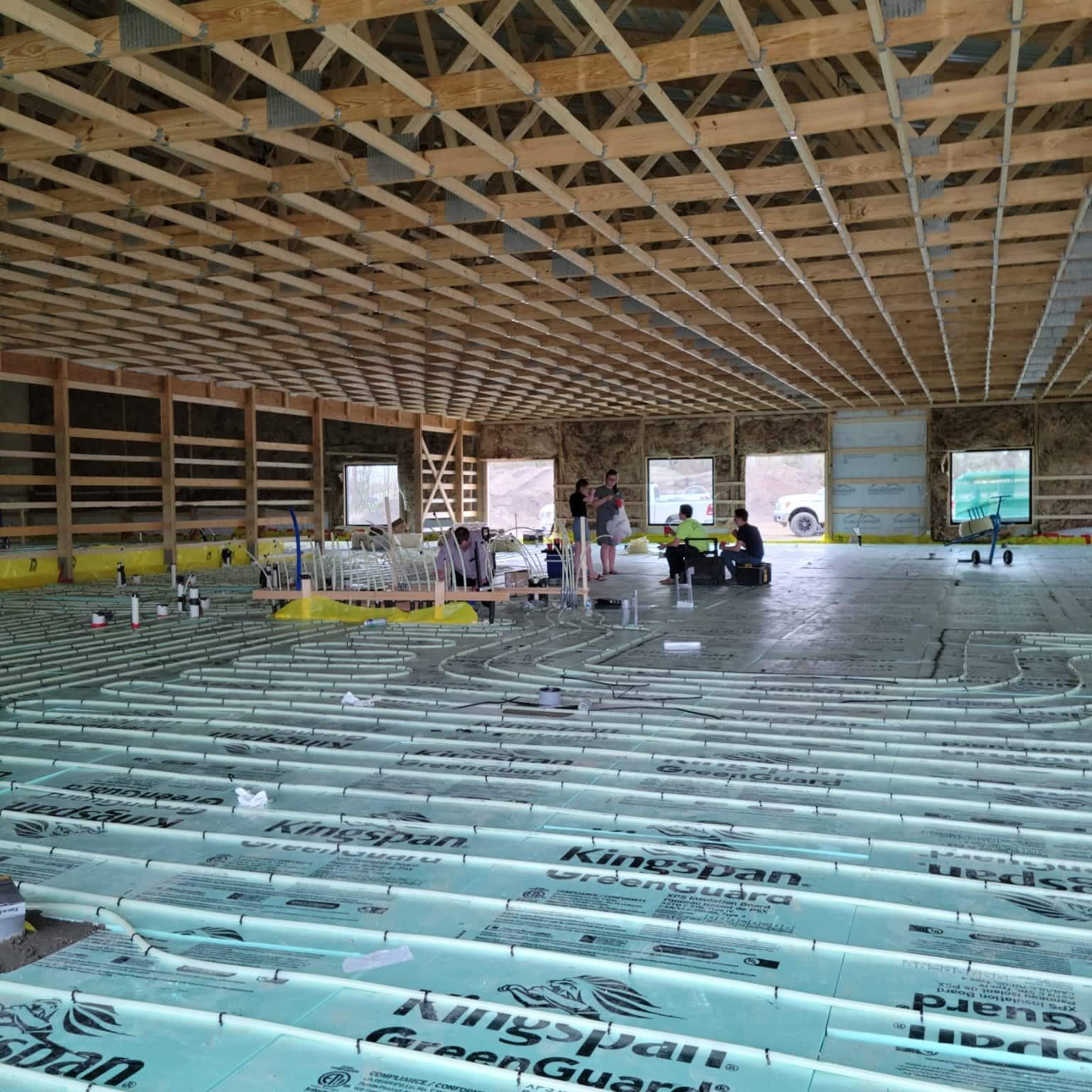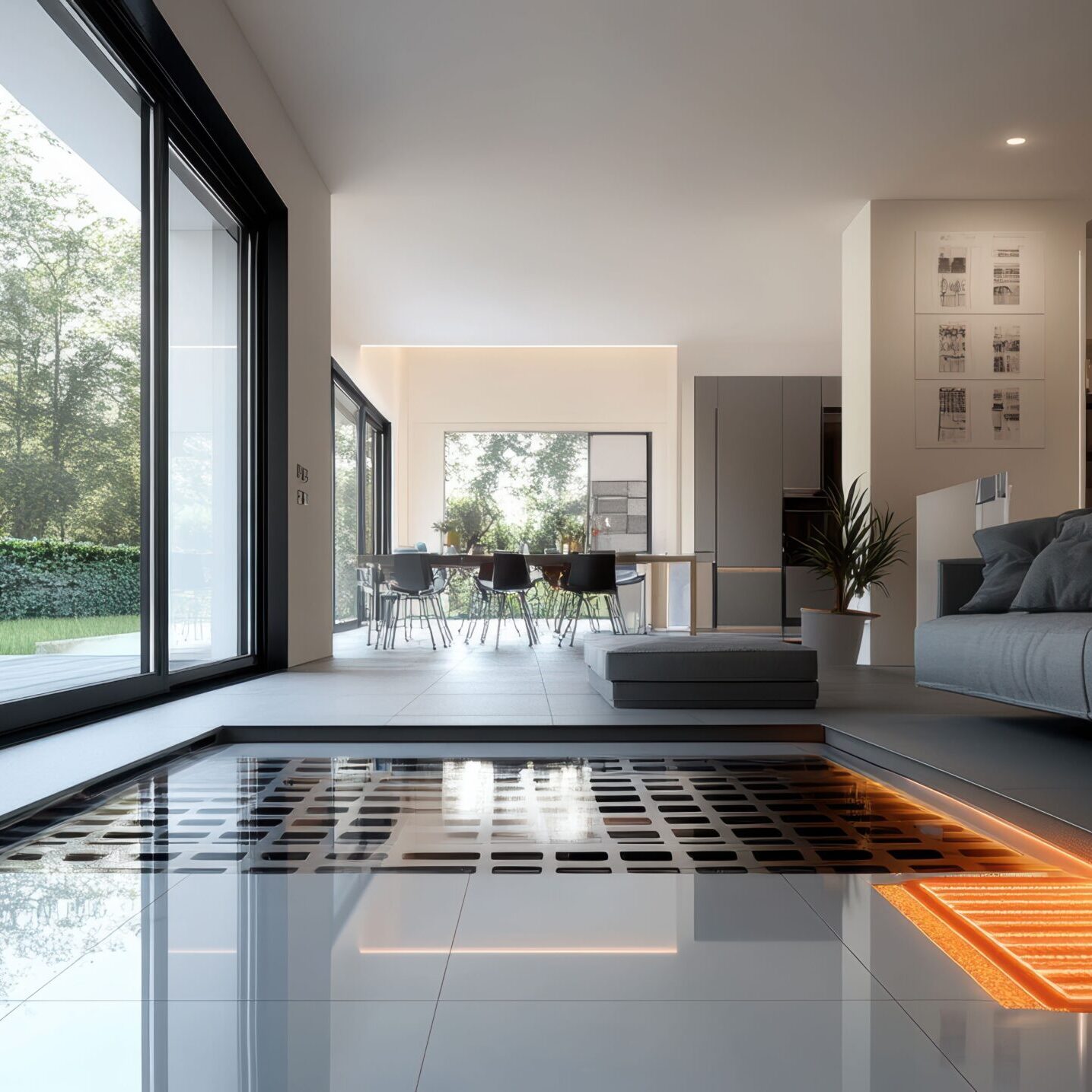
Hydronic radiant floor heating is a system where hot water circulates through tubes beneath your floors to heat your home efficiently. This article will explain how it works, highlight its benefits like energy efficiency and better air quality, and cover installation and maintenance tips to help you decide if it’s right for you.
Key Takeaways
- Hydronic radiant floor heating utilizes hot water circulation through tubing beneath the floor, providing efficient and even heat distribution while reducing allergen spread.
- The installation process involves preparing the mechanical room, laying the tubes through wet or dry methods, and connecting system components, with professional installation typically recommended due to complexity.
- Regular maintenance, including monitoring pressure levels and bleeding the system, is crucial for ensuring optimal performance and energy efficiency, which can result in significant cost savings over time.
Understanding Hydronic Radiant Floor Heating
Hydronic radiant floor heating is a method that uses hot water circulated through tubing beneath the floor to provide warmth. This system utilizes a boiler to heat the water, which is then distributed through pipes installed beneath the floor’s surface, ensuring even distribution of heat across the room. Unlike traditional forced-air systems, hydronic heating minimizes heat loss associated with duct systems, making it a highly energy-efficient option for home heating.

One of the standout benefits of hydronic systems is their health-friendly nature. Since they don’t rely on blowing air through ducts, they do not distribute allergens and dust, making them an excellent choice for allergy sufferers. Moreover, these systems often include a thermostat, allowing users to regulate temperatures efficiently across different areas of their home, enhancing comfort and control.
Whether used in new constructions or retrofits, hydronic radiant heating applications cater to various needs, delivering consistent warmth and eliminating the cold spots often associated with other heating methods. This type of radiant heating ensures that every corner of your home remains cozy, making it a superior choice for both energy efficiency and comfort.
Components of a Hydronic Radiant Floor Heating System
A hydronic radiant floor heating system is composed of several key components that work together to provide efficient home heating. At the heart of the system is the boiler, responsible for heating the water that circulates through the radiant floor system. NextGen Boilers offer a range of eco-friendly electric boilers that are designed for easy installation and efficient performance.
Circulating pumps are another crucial component, facilitating the movement of heated water through the pipes. These pumps ensure that each area of the floor receives adequate warmth, maintaining a consistent temperature throughout the space. Expansion tanks are also vital, accommodating changes in water volume as it heats and cools, thereby maintaining system pressure.
The tubing used in hydronic systems, often made from PEX (cross-linked polyethylene), is specially designed to distribute heat evenly across the floor area. PEX tubing is preferred due to its flexibility and resistance to corrosion. All these components are typically housed in a mechanical room, which should be spacious enough to accommodate the boiler, pump, and other necessary parts while allowing easy access for maintenance.
Installation Process for Hydronic Radiant Floor Heating

Installing a hydronic radiant floor heating system involves several steps, beginning with the preparation of the mechanical room and ending with the connection of all system components. Opting for a NextGen Boiler can significantly reduce installation time, taking only about 45 minutes compared to over 5 hours for conventional boilers. This quick installation is crucial for modern heating systems, minimizing downtime and allowing homeowners to enjoy efficient home heating sooner.
The installation process can be broken down into three main stages: preparing the mechanical room, laying the tubes, and connecting the system. Each stage requires careful planning and execution to ensure the system operates efficiently and effectively.
Preparing the Mechanical Room
The first step in installing a hydronic radiant floor heating system is preparing the mechanical room. The electric boiler should be placed in a well-ventilated area to ensure optimal performance. It’s important to install the boiler on a stable base and make it easily accessible for maintenance. Additionally, the safety relief valve must be installed in accordance with local codes to prevent over-pressurization, ensuring the system operates safely and efficiently.
Creating sufficient space in the mechanical room is essential for housing all components, including the boiler, circulating pump, and expansion tank. This setup not only optimizes performance but also facilitates easier access for regular maintenance and troubleshooting.
Laying the Tubes
Laying the tubes is a critical step in the installation process, as it directly impacts the efficiency and effectiveness of the heating system. There are two main installation types for hydronic systems: wet installations, where the tubing is embedded in concrete, and dry installations, where the tubing is placed beneath the floor. Each method has its advantages, with wet installations offering better thermal mass and dry installations providing easier access for repairs.
The choice between wet and dry installations often depends on the specific requirements of the space and the homeowner’s preferences. Properly laying the tubes ensures even heat distribution across the floor, maximizing the system’s efficiency and comfort.
Connecting the System
The final step in the installation process is connecting the system components. This includes integrating the thermostat, circulating pump, and manifolds to ensure optimal water flow and heating efficiency. Properly connecting these components is vital for the effective operation of the heating system, as it ensures that hot water is distributed evenly across the floor and the desired temperatures are maintained.
Calculating Heating Requirements
Calculating the heating requirements for a hydronic radiant floor heating system is crucial to ensure that the heating output matches the building’s heat loss. This process involves estimating the heat loss of the building, typically measured in British Thermal Units (BTUs). For a building with good insulation, the heat loss is approximately 0.3 BTUs per hour per square foot of floor area per degree Fahrenheit. Understanding these values helps in designing a system that can adequately heat the space without overloading the components.
A floor temperature of 80°F is generally sufficient to produce 27 BTUs per hour, ensuring comfortable warmth without exceeding safe temperature limits. If there is uncertainty about achieving enough heat from the radiant floor, homeowners can consider improving the building’s insulation, looking into supplemental heating methods, or using a supplemental heat source to ensure adequate warmth throughout the space.
Choosing the Right NextGen Boiler
Selecting the right NextGen Boiler for your hydronic radiant floor heating system is essential for achieving optimal performance and efficiency. NextGen Boilers offer a range of models with varying power outputs, including 4kW, 6kW, 8kW, 12kW, and 14.4kW, catering to different heating needs and space sizes. These boilers are designed to provide consistent heating performance, thanks to their modulating capabilities, which adjust the power output based on the current demand.
Ready to experience the future of heating?
NextGen Boilers are not only efficient but also eco-friendly, utilizing cutting-edge technology to reduce energy consumption and lower environmental impact. Their space-saving design allows them to blend seamlessly into any living space, making them an ideal choice for modern homes. Additionally, the easy installation process of NextGen Boilers further enhances their appeal, allowing homeowners to enjoy efficient heating without the hassle of a lengthy setup.
When choosing a NextGen Boiler, it’s important to consider the specific heating requirements of your home. Factors such as the size of the space, insulation quality, and desired temperature levels should all be taken into account to ensure that the selected boiler meets your needs effectively and efficiently.
Professional Installation vs. DIY

The installation of hydronic radiant floor heating systems is generally more complex than electric systems, often requiring professional installation. This complexity arises from the need for specialized equipment, such as boilers and circulating pumps, as well as the careful integration of various components. Professional installation ensures that the system is set up correctly, minimizing the risk of issues and maximizing efficiency.
While DIY installation of electric radiant floor heating systems can be an accessible option for some homeowners, hydronic systems typically require professional expertise due to their complexity and the higher initial costs associated with the required components. Although DIY installation can save money upfront, improper installation can lead to problems that may necessitate professional intervention later, potentially increasing overall costs.
Maintenance Tips for Hydronic Systems
Regular maintenance is crucial for ensuring the optimal performance of hydronic radiant floor heating systems. One of the key maintenance tasks is monitoring the pressure levels in the system. Low pressure may indicate leaks, while high pressure could stress the system, leading to potential damage. Keeping the area around the system clean is also important, as debris accumulation can obstruct airflow and reduce efficiency.
Bleeding the system to eliminate air pockets is another essential maintenance task, as air pockets can impede the flow of hot water and reduce heating efficiency. Regular servicing of the heat source, such as the boiler, is also necessary to maintain the system’s performance and prevent issues.
By following these maintenance tips, homeowners can ensure that their hydronic heating system operates efficiently and provides consistent warmth.
Energy Efficiency and Cost Savings

Hydronic radiant floor heating systems are known for their energy efficiency, often leading to a reduction in energy consumption by approximately 25% compared to conventional forced air heating systems. Effective insulation around the pipes is crucial to maintain heat and improve the overall energy efficiency of the system. Contractors love NextGen Boilers because they offer energy-efficient heating solutions that can help reduce energy bills and provide consistent warmth throughout the home.
Lower water temperatures in hydronic systems contribute to improved boiler efficiency, resulting in additional cost savings over time. Upgrading to a smart thermostat can further enhance temperature control and energy efficiency, allowing homeowners to optimize their heating system and reduce costs.
Investing in a hydronic radiant floor heating system can also increase property value by appealing to buyers looking for modern, efficient heating solutions.
Common Issues and Troubleshooting
Regular inspection of system valves is essential to ensure they function correctly, as they control the flow of hot water and any issues should be resolved quickly. Uneven heating in a hydronic radiant floor system may indicate flow or insulation issues, which can often be resolved by bleeding the system or ensuring proper installation.
Thermostat malfunctions can manifest as unresponsiveness or incorrect temperature readings, which might necessitate wiring checks or recalibration. If areas are not heating evenly, it could signal flow or insulation issues, necessitating professional evaluation.
By addressing these common problems, homeowners can ensure their hydronic heating systems operate efficiently and provide consistent warmth.
Enhancing Home Comfort with Radiant Heat
Radiant heat offers an even distribution of warmth from the floor upwards, enhancing the overall comfort of a room. Hydronic systems are particularly advantageous for larger spaces, as they are designed to distribute heat more evenly across bigger areas. The absence of ductwork in hydronic systems reduces the spread of dust and allergens, improving indoor air quality and potentially lowering health-related costs.
Radiant heating systems provide several benefits:
- Consistent warmth, reducing temperature fluctuations and creating a more comfortable living environment.
- The ability to provide zoned heating, allowing for tailored temperature control in individual rooms, enhancing comfort while minimizing energy waste.
- Silent operation, eliminating the noise commonly associated with traditional heating methods.
- Better indoor humidity levels, preventing the dryness often caused by forced-air systems.

The Benefits of Hydronic Radiant Heating
Hydronic radiant floor heating systems offer numerous benefits, from energy efficiency to improved indoor air quality and consistent warmth. By understanding the components, installation process, and maintenance requirements, homeowners can make informed decisions to enhance their home heating experience. NextGen Boilers provide an eco-friendly and efficient solution, ensuring comfort and cost savings. Embrace the future of home heating with hydronic radiant floor systems and enjoy a warmer, healthier living environment.
Frequently Asked Questions
Estimating heating requirements in a radiant floor system is essential to match the heating output of the floor with the heat loss of the building. This ensures optimal efficiency and comfort in space heating.
Ready to experience the future of heating?
Don’t wait—take the first step today. Whether you’re a contractor or wholesaler, NextGen Boiler is here to meet your needs with innovative, reliable, and efficient solutions.
